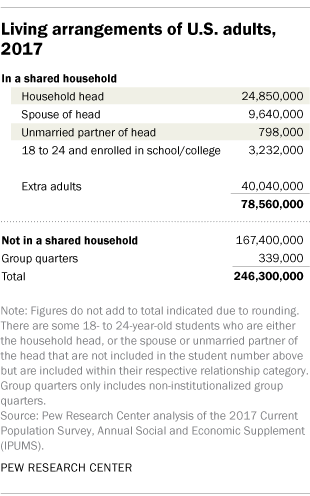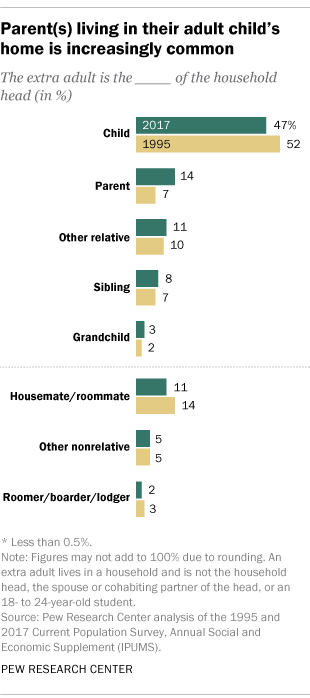
American adults are increasingly sharing a home with other adults with whom they are not romantically involved. This arrangement, known as “doubling up” or shared living, gained notice in the wake of the Great Recession, and nearly a decade later, the prevalence of shared living has continued to grow.
While the rise in shared living during and immediately after the recession was attributed in large part to a growing number of Millennials moving back in with their parents, the longer-term increase has been partially driven by a different phenomenon: parents moving in with their adult children.
In 2017, nearly 79 million adults (31.9% of the adult population) lived in a shared household – that is, a household with at least one “extra adult” who is not the household head, the spouse or unmarried partner of the head, or an 18- to 24-year-old student. In 1995, the earliest year with comparable data, 55 million adults (28.8%) lived in a shared household. In 2004, at the peak of homeownership and before the onset of the home foreclosure crisis, 27.4% of adults shared a household.
A shared household is defined somewhat differently from a multigenerational household (although the two can overlap), as shared households can include unrelated adults and adult siblings. More adults live in shared households than multigenerational households: In 2014, 61 million Americans (including children) resided in multigenerational households.

The nearly 79 million adults living in a shared household include about 25 million adults who own or rent the household. An additional 10 million adults are the spouse or unmarried partner of the head of the household. Another 40 million, or 16% of all adults, are the “extra adult” in the shared household. This share living in someone else’s household is up from 14% in 1995.

Adults who live in someone else’s household typically live with a relative. Today, 14% of adults living in someone else’s household are a parent of the household head, up from 7% in 1995. Some 47% of extra adults today are adult children living in their mom and/or dad’s home, down from 52% in 1995. Other examples of extra adults are a sibling living in the home of a brother or sister, or a roommate.
In 2017, only 18% of extra adults lived in a household in which the head was unrelated (typically a housemate or roommate). Living with nonrelatives has become less prevalent since 1995, when 22% of extra adults lived with a nonrelative.
Regardless of their relationship to the household head, young adults are more likely than middle-aged or older adults to live in someone else’s household. Among those younger than 35, 30% were the extra adult in someone else’s household in 2017, up from 26% in 1995. Among 35- to 54-year-olds, 12% were living in someone else’s household, an increase from 9% in 1995. Today 10% of 55- to 64-year-olds are an extra adult, up from 6% in 1995. The only adult group that isn’t more likely than before to live in another adult’s household is those ages 75 and older (10% in both years).
The rise in shared living may have implications for the nature of household finances – that is, how income and expenses are shared among members.
In addition, the increase in “doubling up” is offsetting other social trends bearing on the nature of the nation’s households and demand for housing. While Americans are less likely to be living with a spouse or unmarried partner in their household, the rise in doubling up means more adults are living with nonrelatives and with relatives other than romantic partners. As a result, the average number of adults per household has not declined since 1995, and consequently, the number of households per adult has not increased.
In fact, household formation, or the number of households for every 100 adults, has recently fallen to very modest levels for several age groups. For example, in 2017 there were 31 households headed by an adult younger than 35 for every 100 adults in that age bracket (adjusted for the age bias in head-of-household status), among the lowest rate of household formation for this age group since the early 1970s. Decreased household formation is not confined to young adults. Last year there were 61 households headed by a 65- to 74-year-old for every 100 65- to 74-year-olds. While this marked a slight statistical increase from 2014, the last time household formation rates were that low among this demographic was 1972.
The rise in shared living is likely not simply a response to rising housing costs and weak incomes. Nonwhite adults are much more likely than white adults to be doubled up, mirroring their greater propensity to live in multigenerational households. Nonwhite adults are a growing share of the adult population, and thus some of the rise in shared living arrangements is due to longer-running demographic change.
